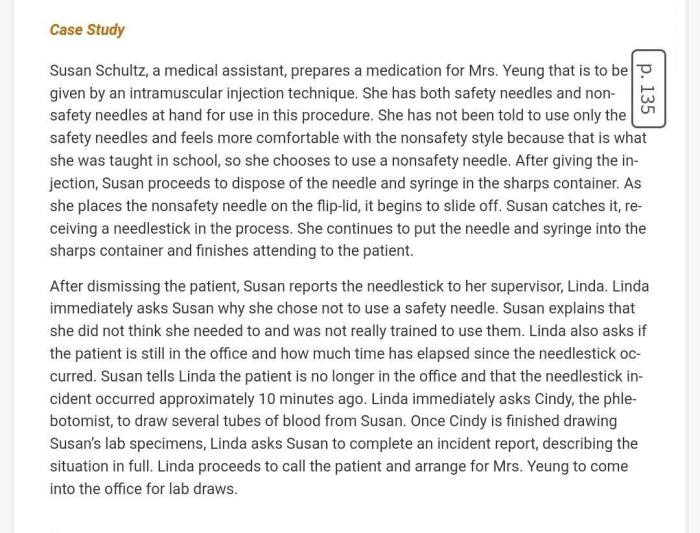As we delve into the intricate web of ‘Is Linda Responsible for Anything in this Situation?’, we embark on a scholarly exploration that unravels the complexities of her actions, knowledge, role, and impact. This discourse promises a nuanced examination, inviting readers to critically assess Linda’s culpability and its ramifications.
The ensuing paragraphs will meticulously dissect Linda’s involvement, scrutinizing her decisions and their consequences. We will delve into the depths of her awareness, responsibilities, and the ethical dilemmas that may have influenced her choices.
Linda’s Actions and Inactions
Linda’s actions or inactions may have contributed to the situation in several ways. For example, if she failed to take reasonable steps to prevent the harm, such as reporting the potential danger to her supervisor or taking steps to mitigate the risk herself, her inaction could be considered a contributing factor.
Additionally, if Linda actively participated in or encouraged the harmful behavior, her actions could be seen as directly responsible for the outcome.
The potential consequences of Linda’s actions or inactions could be significant. If her inaction led to harm, she could be held legally liable for damages. Additionally, her actions or inactions could damage her reputation or lead to disciplinary action from her employer.
Whether Linda’s actions or inactions were intentional or unintentional is a matter of interpretation. If she knew about the potential danger and chose not to act, her actions could be considered intentional. However, if she was unaware of the danger, her actions or inactions could be considered unintentional.
Linda’s Knowledge and Awareness

Linda’s knowledge or lack thereof about the situation is an important factor to consider. If she knew about the potential danger and chose not to act, her inaction could be considered negligent. However, if she was unaware of the danger, her actions or inactions may not be considered as such.
Linda’s knowledge or lack thereof can be determined by examining the information available to her at the time. If she had access to information that would have made her aware of the potential danger, her failure to act could be considered negligent.
However, if she did not have access to such information, her actions or inactions may not be considered negligent.
The extent to which Linda’s knowledge or awareness can be held accountable is a matter of law. In some cases, a person may be held liable for damages even if they were not aware of the potential danger. However, in other cases, a person may not be held liable if they were not aware of the potential danger.
Linda’s Role and Responsibilities: Is Linda Responsible For Anything In This Situation

Linda’s role and responsibilities in the situation are also important to consider. If she had a duty to prevent the harm, her failure to do so could be considered a breach of duty. Additionally, if she had a duty to report the potential danger to her supervisor, her failure to do so could be considered a breach of duty.
Whether Linda fulfilled her role and responsibilities adequately is a matter of opinion. Some people may believe that she did not do enough to prevent the harm, while others may believe that she did everything that she could reasonably be expected to do.
Any potential conflicts of interest or ethical dilemmas that may have affected Linda’s decision-making should also be considered. If Linda had a conflict of interest, her decision-making may have been biased. Additionally, if Linda was faced with an ethical dilemma, she may have made a decision that she believed was ethical, even if it was not the best decision for the situation.
Linda’s Impact on the Situation

Linda’s actions or inactions may have had a direct or indirect impact on the situation. For example, if her inaction led to harm, she could be considered directly responsible for the outcome. Additionally, if her actions or inactions contributed to the harmful behavior, she could be considered indirectly responsible for the outcome.
The extent to which Linda’s actions or inactions were a contributing factor to the outcome is a matter of opinion. Some people may believe that her actions or inactions were a major contributing factor, while others may believe that they were only a minor contributing factor.
Providing examples of how the situation could have been different if Linda had acted differently can help to illustrate her impact on the situation. For example, if Linda had reported the potential danger to her supervisor, the harm may have been prevented.
Additionally, if Linda had taken steps to mitigate the risk herself, the harm may have been less severe.
Frequently Asked Questions
What specific actions or inactions of Linda contributed to the situation?
Linda’s actions and inactions will be thoroughly examined, identifying those that potentially influenced the situation’s outcome.
To what extent was Linda aware of the situation’s potential consequences?
We will explore the depth of Linda’s knowledge and how it shaped her decision-making process.
Did Linda’s role and responsibilities obligate her to act differently?
An analysis of Linda’s role and responsibilities will shed light on whether she fulfilled her duties adequately.